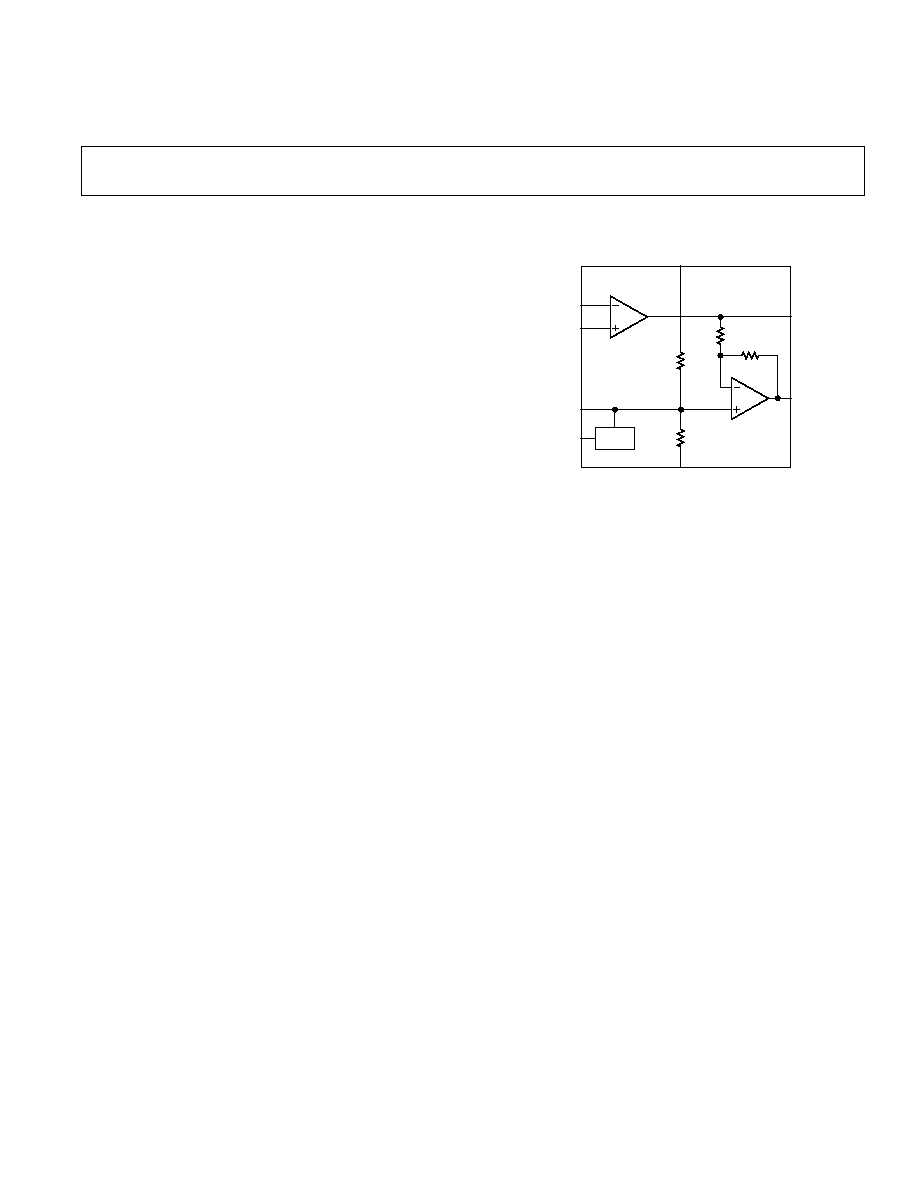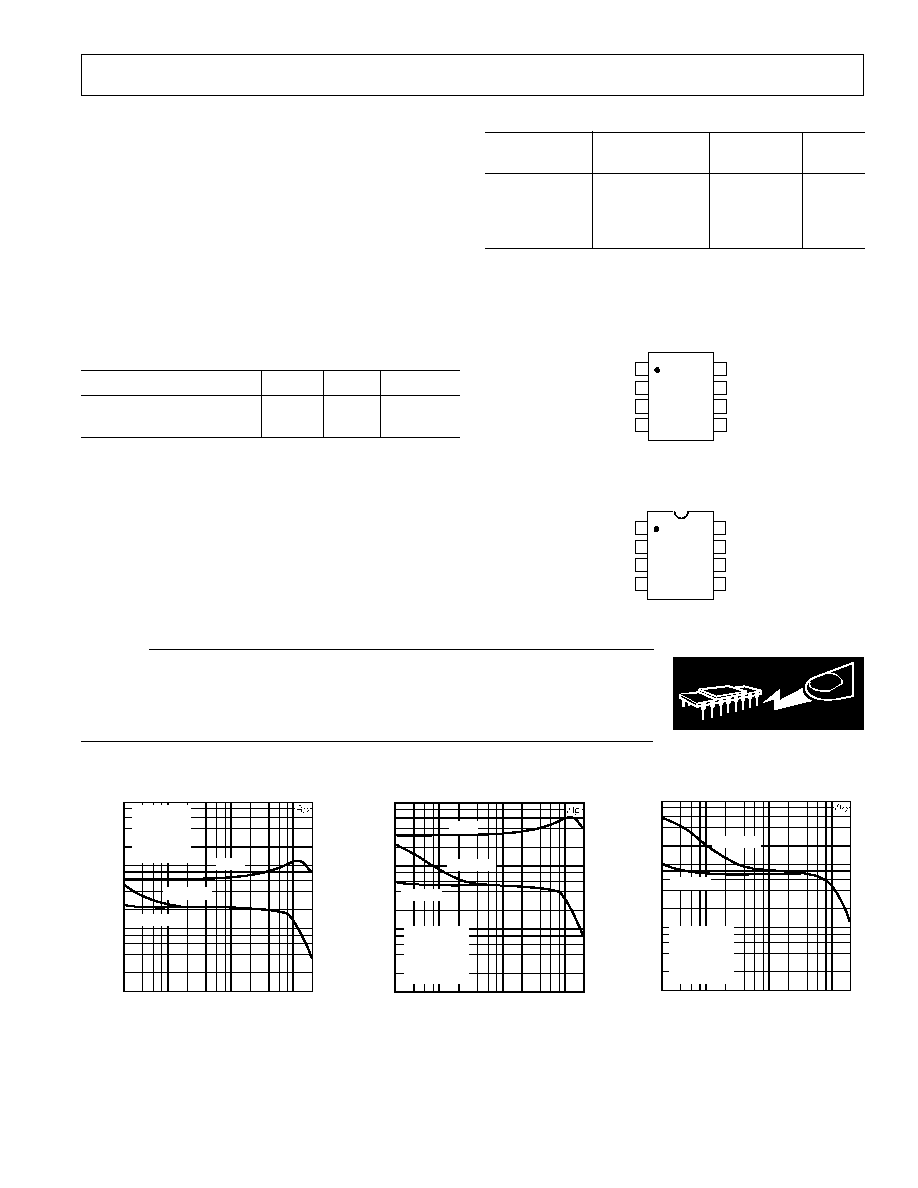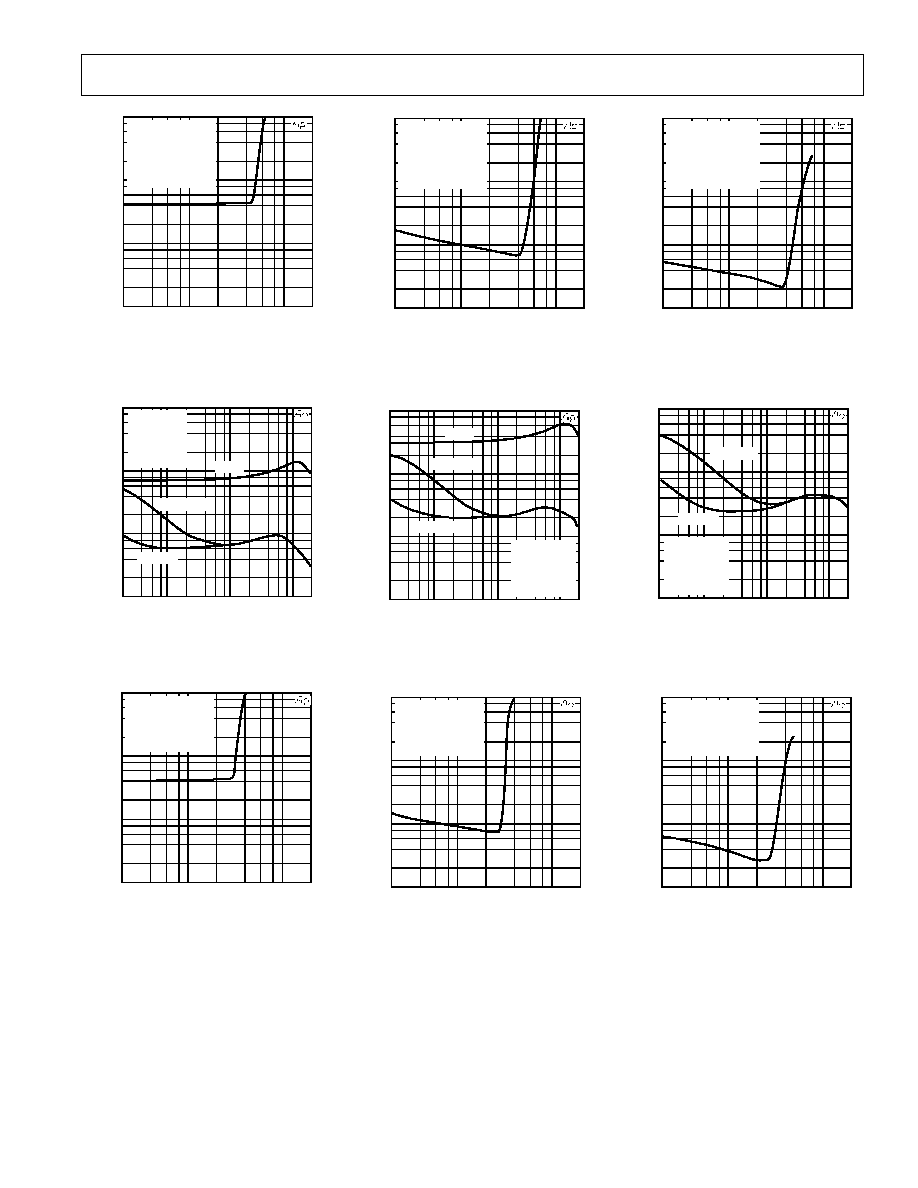 | –≠–ª–µ–∫—Ç—Ä–æ–Ω–Ω—ã–π –∫–æ–º–ø–æ–Ω–µ–Ω—Ç: SSM2211 | –°–∫–∞—á–∞—Ç—å:  PDF PDF  ZIP ZIP |

FUNCTIONAL BLOCK DIAGRAM
V
OUT
B
IN ≠
IN +
SHUTDOWN
BYPASS
V
OUT
A
V +
V ≠ (GND)
BIAS
REV. 0
Information furnished by Analog Devices is believed to be accurate and
reliable. However, no responsibility is assumed by Analog Devices for its
use, nor for any infringements of patents or other rights of third parties
which may result from its use. No license is granted by implication or
otherwise under any patent or patent rights of Analog Devices.
a
Low Distortion 1.5 Watt
Audio Power Amplifier
SSM2211*
One Technology Way, P.O. Box 9106, Norwood. MA 02062-9106, U.S.A.
Tel: 781/329-4700 World Wide Web Site: http://www.analog.com
Fax: 781/326-8703 © Analog Devices, Inc., 1997
FEATURES
1.5 Watt Output
1
Differential (BTL
2
)Output
Single-Supply Operation: 2.7 V to 5.5 V
Functions Down to 1.75 V
Wide Bandwidth: 4 MHz
Highly Stable, Phase Margin: > 80
Degrees
Low Distortion: 0.2% THD @ 1 W Output
Excellent Power Supply Rejection
APPLICATIONS
Portable Computers
Personal Wireless Communicators
Hands-Free Telephones
Speakerphones
Intercoms
Musical Toys and Speaking Games
GENERAL DESCRIPTION
The SSM2211 is a high performance audio amplifier that delivers 1
W RMS of low distortion audio power into a bridge-connected 8
speaker load, (or 1.5 W RMS into 4
load). It operates over a wide
temperature range and is specified for single-supply voltages between
2.7 V and 5.5 V. When operating from batteries, it will continue to
operate down to 1.75 V. This makes the SSM2211 the best choice
for unregulated applications such as toys and games. Featuring a
4 MHz bandwidth, distortion below 0.2 % THD @ 1 W, and the
patented Thermal Coastline
leadframe, superior performance is de-
livered at higher power or lower speaker load impedance than com-
petitive units. The advanced mechanical packaging of the SSM2211
gives lower chip temperature, which ensures highly reliable operation
and enhanced trouble free life.
*Protected by U.S. Patent No. 5,519,576
1
1.5 W @ 4
, +25
∞
C ambient, < 1% THD, 5 V supply, 4 layer PCB.
2
Bridge Tied Load
The low differential dc output voltage results in negligible losses
in the speaker winding, and makes high value dc blocking capaci-
tors unnecessary. Battery life is extended by using the Shutdown
mode, which reduces quiescent current drain to typically 100 nA.
The SSM2211 is designed to operate over the ≠20
∞
C to +85
∞
C
temperature range. See Figure 49 for information on the Thermal
Coastline lead frame. The SSM2211 is available in an SO-8 sur-
face mount package. DIP samples are available; you should request
a special quotation on production quantities. An evaluation board
is available upon request of your local Analog Device sales office.
Applications include personal portable computers, hands-free
telephones and transceivers, talking toys, intercom systems and
other low voltage audio systems requiring 1 W output power.

REV. 0
≠2≠
SSM2211≠SPECIFICATIONS
ELECTRICAL CHARACTERISTICS
Parameter
Symbol
Conditions
Min
Typ
Max
Units
GENERAL CHARACTERISTICS
Differential Output Offset Voltage
V
OOS
A
VD
= 2
4
50
mV
Output Impedence
Z
OUT
0.1
SHUTDOWN CONTROL
Input Voltage High
V
IH
I
SY
= < 100
µ
A
3.0
V
Input Voltage Low
V
IL
I
SY
= Normal
1.3
V
POWER SUPPLY
Power Supply Rejection Ratio
PSRR
V
S
= 4.75 V to 5.25 V
66
dB
Supply Current
I
SY
V
O1
= V
O2
= 2.5 V
9.5
mA
Supply Current, Shutdown Mode
I
SD
Pin 1 = V
DD
, See Figure 29
100
nA
DYNAMIC PERFORMANCE
Gain Bandwidth
GBP
4
MHz
Phase Margin
ÿ
0
86
degrees
AUDIO PERFORMANCE
Total Harmonic Distortion
THD + N
P = 0.5 W into 8
, f = 1 kHz
0.15
%
Total Harmonic Distortion
THD + N
P = 1.0 W into 8
, f = 1 kHz
0.2
%
Voltage Noise Density
e
n
f = 1 kHz
85
nV
Hz
ELECTRICAL CHARACTERISTICS
Parameter
Symbol
Conditions
Min
Typ
Max
Units
GENERAL CHARACTERISTICS
Differential Output Offset Voltage
V
OOS
A
VD
= 2
5
50
mV
Output Impedence
Z
OUT
0.1
SHUTDOWN INPUT
Input Voltage High
V
IH
I
SY
= < 100
µ
A
1.7
V
Input Voltage Low
V
IL
1
V
POWER SUPPLY
Supply Current
I
SY
V
O1
= V
O2
= 1.65 V
5.2
mA
Supply Current, Shutdown Mode
I
SD
Pin 1 = V
DD
, See Figure 29
100
nA
AUDIO PERFORMANCE
Total Harmonic Distortion
THD + N
P = 0.35 W into 8
, f = 1 kHz
0.1
%
ELECTRICAL CHARACTERISTICS
Parameter
Symbol
Conditions
Min
Typ
Max
Units
GENERAL CHARACTERISTICS
Differential Output Offset Voltage
V
OOS
A
VD
= 2
5
50
mV
Output Impedence
Z
OUT
0.1
SHUTDOWN CONTROL
Input Voltage High
V
IH
I
SY
= < 100
µ
A
1.5
V
Input Voltage Low
V
IL
I
SY
= Normal
0.8
V
POWER SUPPLY
Supply Current
I
SY
V
O1
= V
O2
= 1.35 V
4.2
mA
Supply Current, Shutdown Mode
I
SD
Pin 1 = V
DD
, See Figure 29
100
nA
AUDIO PERFORMANCE
Total Harmonic Distortion
THD + N
P = 0.25 W into 8
, f = 1 kHz
0.1
%
Specifications subject to change without notic
(V
S
= 5.0 V, T
A
= 25 C, R
L
= 8
, C
B
= 0.1 F, V
CM
= V
D
/2 unless otherwise noted)
(V
S
= 3.3 V, T
A
= 25 C, R
L
= 8
, C
B
= 0.1 F, V
CM
= V
D
/2 unless otherwise noted)
(V
S
= 2.7 V, T
A
= 25 C, R
L
= 8
, C
B
= 0.1 F, V
CM
= V
S
/2 unless otherwise noted)

SSM2211
REV. 0
≠3≠
CAUTION
ESD (electrostatic discharge) sensitive device. Electrostatic charges as high as 4000 V readily
accumulate on the human body and test equipment and can discharge without detection. Although
the SSM2211 features proprietary ESD protection circuitry, permanent damage may occur on
devices subjected to high energy electrostatic discharges. Therefore, proper ESD precautions are
recommended to avoid performance degradation or loss of functionality.
ABSOLUTE MAXIMUM RATINGS
1,2
Supply Voltage . . . . . . . . . . . . . . . . . . . . . . . . . . . . . . . . . +6 V
Input Voltage . . . . . . . . . . . . . . . . . . . . . . . . . . . . . . . . . . . V
DD
Common Mode Input Voltage . . . . . . . . . . . . . . . . . . . . . . V
DD
ESD Susceptibility . . . . . . . . . . . . . . . . . . . . . . . . . . . . . 2000 V
Storage Temperature Range . . . . . . . . . . . .
65
∞
C to +150
∞
C
Operating Temperature Range . . . . . . . . . . .
20
∞
C to +85
∞
C
Junction Temperature Range . . . . . . . . . . . .
65
∞
C to +165
∞
C
Lead Temperature Range (Soldering, 60 sec) . . . . . . .
300
∞
C
NOTES
1
Absolute maximum ratings apply at +25
∞
C, unless otherwise noted.
2
Stresses above those listed under Absolute Maximum Ratings may cause perma -
nent damage to the device. This is a stress rating only; the functional operation of
the device at these or any other conditions above those indicated in the opera tional
sections of this specification is not implied. Exposure to absolute maximum rating
conditions for extended periods may affect device reliability.
Package Type
JA
1
JC
Units
8-Lead SOIC (S)
98
43
∞
C/W
8-Lead PDIP (P)
2
103
43
∞
C/W
NOTES
1
For the SOIC package,
JA
is measured with the device soldered to a 4-layer
printed circuit board.
2
Special order only.
FREQUENCY ≠ Hz
THD + N ≠ %
10
1
0.01
20
100
20k
1k
10k
0.1
T
A
= 25 C
V
DD
= 5V
A
VD
= 2 (BTL)
R
L
= 8
P
L
= 500mW
C
B
= 0
C
B
= 0.1 F
C
B
= 1 F
Figure 1. THD+N vs. Frequency
FREQUENCY ≠ Hz
THD + N ≠ %
10
1
0.01
20
100
20k
1k
10k
0.1
T
A
= 25 C
V
DD
= 5V
A
VD
= 10 (BTL)
R
L
= 8
P
L
= 500mW
C
B
= 0
C
B
= 0.1 F
C
B
= 1 F
Figure 2. THD+N vs. Frequency
FREQUENCY ≠ Hz
THD + N ≠ %
10
1
0.01
20
100
20k
1k
10k
0.1
T
A
= 25 C
V
DD
= 5V
A
VD
= 20 (BTL)
R
L
= 8
P
L
= 500mW
C
B
= 0.1 F
C
B
= 1 F
Figure 3. THD+N vs. Frequency
ORDERING GUIDE
Temperature
Package
Package
Model
Range
Description
Options
SSM2211S
≠20
∞
C to +85
∞
C
8-Lead SOIC
SO-8
SSM2211S-reel
≠20
∞
C to +85
∞
C
8-Lead SOIC
SO-8
SSM2211S-reel7
≠20
∞
C to +85
∞
C
8-Lead SOIC
SO-8
SSM2211P
≠20
∞
C to +85
∞
C
8-Lead PDIP
N-8
*
*
Special order only.
PIN CONFIGURATIONS
8-Lead SOIC
(SO-8)
1
2
3
4
8
7
6
5
TOP VIEW
(Not to Scale)
SHUTDOWN
V
OUT
A
+V
≠V
V
OUT
B
BYPASS
+IN
≠IN
8-Lead Plastic DIP
(N-8)
1
2
3
4
8
7
6
5
TOP VIEW
(Not to Scale)
SHUTDOWN
V
OUT
A
+V
≠V
V
OUT
B
BYPASS
+IN
≠IN
WARNING!
ESD SENSITIVE DEVICE

FREQUENCY ≠ Hz
THD + N ≠ %
10
1
0.01
20
100
20k
1k
10k
0.1
T
A
= 25 C
V
DD
= 5V
A
VD
= 2 (BTL)
R
L
= 8
P
L
= 1W
C
B
= 0
C
B
= 0.1 F
C
B
= 1 F
Figure 4. THD+N vs. Frequency
P
OUTPUT
≠ W
THD + N ≠ %
10
1
0.01
20n
0.1
2
0.1
1
T
A
= 25 C
V
DD
= 5V
A
VD
= 2 (BTL)
R
L
= 8
FREQUENCY = 20Hz
C
B
= 0.1 F
Figure 7. THD+N vs. P
OUTPUT
FREQUENCY ≠ Hz
THD + N ≠ %
10
1
0.01
20
100
20k
1k
10k
0.1
T
A
= 25 C
V
DD
= 3.3V
A
VD
= 2 (BTL)
R
L
= 8
P
L
= 350mW
C
B
= 0
C
B
= 0.1 F
C
B
= 1 F
Figure 10. THD+N vs. Frequency
FREQUENCY ≠ Hz
THD + N ≠ %
10
1
0.01
20
100
20k
1k
10k
0.1
T
A
= 25 C
V
DD
= 5V
A
VD
= 20 (BTL)
R
L
= 8
P
L
= 1W
C
B
= 0.1 F
C
B
= 1 F
Figure 6. THD+N vs. Frequency
P
OUTPUT
≠ W
THD + N ≠%
10
1
0.01
20n
0.1
2
0.1
1
T
A
= 25 C
V
DD
= 5V
A
VD
= 2 (BTL)
R
L
= 8
FREQUENCY = 20kHz
C
B
= 0.1 F
Figure 9. THD+N vs. P
OUTPUT
FREQUENCY ≠ Hz
THD + N ≠ %
10
1
0.01
20
100
20k
1k
10k
0.1
T
A
= 25 C
V
DD
= 3.3V
A
VD
= 20 (BTL)
R
L
= 8
P
L
= 350mW
C
B
= 0.1 F
C
B
= 1 F
Figure 12. THD+N vs. Frequency
FREQUENCY ≠ Hz
THD + N ≠ %
10
1
0.01
20
100
20k
1k
10k
0.1
T
A
= 25 C
V
DD
= 5V
A
VD
= 10 (BTL)
R
L
= 8
P
L
= 1W
C
B
= 0
C
B
= 0.1 F
C
B
= 1 F
Figure 5
.
THD+N vs. Frequency
P
OUTPUT
≠ W
THD + N ≠ %
10
1
0.01
20n
0.1
2
0.1
1
T
A
= 25 C
V
DD
= 5V
A
VD
= 2 (BTL)
R
L
= 8
FREQUENCY = 1kHz
C
B
= 0.1 F
Figure 8. THD+N vs. P
OUTPUT
FREQUENCY ≠ Hz
THD + N ≠ %
10
1
0.01
20
100
20k
1k
10k
0.1
T
A
= 25 C
V
DD
= 3.3V
A
VD
= 10 (BTL)
R
L
= 8
P
L
= 350mW
C
B
= 0
C
B
= 0.1 F
C
B
= 1 F
Figure 11. THD+N vs. Frequency
SSM2211≠Typical Performance Characteristics
REV. 0
≠4≠

SSM2211
REV. 0
≠5≠
P
OUTPUT
≠ W
THD + N ≠%
10
1
0.01
20n
0.1
2
0.1
1
T
A
= 25 C
V
DD
= 3.3V
A
VD
= 2 (BTL)
R
L
= 8
FREQUENCY = 20Hz
C
B
= 0.1 F
Figure 13. THD+N vs. P
OUTPUT
FREQUENCY ≠ Hz
THD + N ≠ %
10
1
0.01
20
100
20k
1k
10k
0.1
T
A
= 25 C
V
DD
= 2.7V
A
VD
= 2 (BTL)
R
L
= 8
P
L
= 250mW
C
B
= 0
C
B
= 0.1 F
C
B
= 1 F
Figure 16. THD+N vs. Frequency
P
OUTPUT
≠ W
THD + N ≠%
10
1
0.01
20n
0.1
2
0.1
1
T
A
= 25 C
V
DD
= 2.7V
A
VD
= 2 (BTL)
R
L
= 8
FREQUENCY = 20Hz
Figure 19. THD+N vs. P
OUTPUT
P
OUTPUT
≠ W
THD + N ≠%
10
1
0.01
20n
0.1
2
0.1
1
T
A
= 25 C
V
DD
= 3.3V
A
VD
= 2 (BTL)
R
L
= 8
FREQUENCY = 20kHz
C
B
= 0.1 F
Figure 15. THD+N vs. Frequency
FREQUENCY ≠ Hz
THD + N ≠ %
10
1
0.01
20
100
20k
1k
10k
0.1
T
A
= 25 C
V
DD
= 2.7V
A
VD
= 20 (BTL)
R
L
= 8
P
L
= 250mW
C
B
= 0.1 F
C
B
= 1 F
Figure 18. THD+N vs. Frequency
P
OUTPUT
≠ W
THD + N ≠%
10
1
0.01
20n
0.1
2
0.1
1
T
A
= 25 C
V
DD
= 2.7V
A
VD
= 2 (BTL)
R
L
= 8
FREQUENCY = 20kHz
Figure 21. THD+N vs. P
OUTPUT
P
OUTPUT
≠ W
THD + N ≠%
10
1
0.01
20n
0.1
2
0.1
1
T
A
= 25 C
V
DD
= 3.3V
A
VD
= 2 (BTL)
R
L
= 8
FREQUENCY = 1kHz
C
B
= 0.1 F
Figure 14. THD+N vs. P
OUTPUT
FREQUENCY ≠ Hz
THD + N ≠ %
10
1
0.01
20
100
20k
1k
10k
0.1
T
A
= 25 C
V
DD
= 2.7V
A
VD
= 10 (BTL)
R
L
= 8
P
L
= 250mW
C
B
= 0
C
B
= 0.1 F
C
B
= 1 F
Figure 17. THD+N vs. Frequency
P
OUTPUT
≠ W
THD + N ≠%
10
1
0.01
20n
0.1
2
0.1
1
T
A
= 25 C
V
DD
= 2.7V
A
VD
= 2 (BTL)
R
L
= 8
FREQUENCY = 1kHz
Figure 20. THD+N vs. P
OUTPUT




